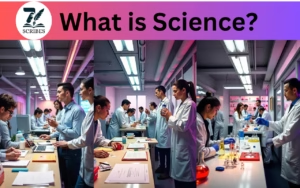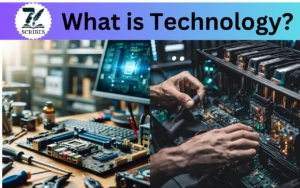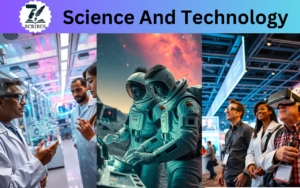The modern world is largely shaped by science and technology, which also influence almost every aspect of our daily lives. Science uses experimentation and observation to help us understand the natural world, and technology uses that understanding to develop novel solutions to problems in the real world. From space travel and medical advancements to cellphones and renewable energy, the combination of science and technology is transforming industries and raising people’s standard of living all over the world. These fields are changing quickly, opening up new avenues for innovation and discovery that advance society and shape the future.
- What is Science?
- What is Technology?
- Connection of Science and Technology
- A Concise History of Modern Science
- Pivotal Scientific Progression
- Different Types of Technology
- Physics
- Chemistry
- Biology
- Computer Science
What is Science?
Science is the systematic study of facts, procedures, and phenomena about the world through different types of observation, experimentation, and analysis. It helps us to understand how natural things work and provides us with knowledge about our universe.

What is Technology?
The word technology is derived from two Greek words “Tekne” which means art or craft and “Logia” which means related to study. However, the word together Tekenologia means systematic treatment, from this word it gradually changes into the word technology. Technology is defined as the things created by human beings that can make our lives easier and solve difficult problems in an efficient and better way.

Connection of Science and Technology
Science and technology are intelligently connected, with each sparking and advancing the other in a dynamic collaboration. Both science and technology play an important role in every field of life without each other we cannot move ahead. Science provides the basic concept of natural phenomena through research and experimentation, which introduces the groundwork for technological innovation.
On the other hand, technology gives new tools and techniques that enable scientists to conduct more costly and complex research. Complexities such as high-resolution microscopes and cultivated computational models have transformed scientific exploration and discovery. This relationship between science and technology creates a feedback revolution where scientific inventions energize new technological implementations and technological improvements. Together, science and technology inspire progress, solving daily life problems and spreading our understanding of the universe. Simply we can say that both science and technology are dependent to each other.

The Progression of Scientific Concepts
A Concise History of Modern Science
The history of science is found in the ancient civilizations of Mesopotamians and Egyptians. They start to think about the observations and behavior of the universe. The birth of modern science starts in the 16th and 17th centuries. Well-known scientists like Galileo Galilei(1564–1642), Robert Hooke (1635–1703), Isaac Newton (1643–1727) etc. Who led the foundation of modern science. In the 18th century, science rapidly evolved and invented the computer. The rapid increase in the development of science occurred during the 19th century when the branches of science were distinguished. Now, in the 21st century, it is the peak of science and there is much more to invent and resolve the mysteries of the universe.
Pivotal Scientific Progression
Pivotal scientific progression consists of significant breakthroughs or developments that transform understanding within a domain, such as radical discoveries, emergent technologies, or theoretical alterations. These developments modify existing knowledge and boost further exploration and revolution.
Understanding Technology Basics
Different Types of Technology
Different types of technology are discussed below:
(i) Information Technology :
Information Technology(IT) Indicates the use, advancement, and management of computer systems, software, and the web to operate, keep, and send data. It Includes different perspectives, including:
- Software Development – Making applications and systems.
- Network Administration -Controlling and providing security to network infrastructure.
- Database Management – Systematizing and handling data.
- Cybersecurity- Defending systems and data from cyber risks.
(ii) Nanotechnology :
Nanotechnology encompasses manipulating substances at the elemental and molecular scale, ordinarily below 100 nanometers. This technology permits the formation of materials and tools with distinct features and applications.
- Nanomedicine – Creating directed medication supply systems and analytical tools.
- Nanoelectronics -Designing minimized, accelerated, and more optimal circuit-based machines.
- Nanocoatings – Implementing layers that provide upgraded durability or utility.
(iii) Artificial Intelligence (AI) :
Artificial Intelligence (AI) is the specialty of computer science concentrated on designing systems that can perform functions needing human mental acuity. Some important and famous areas of AI are given below:
- Machine Learning – Algorithms that permit systems to understand data and advance over time.
- Natural Language Processing (NLP) – Grasp and create human speech.
- Computer Sight – Explaining and evaluating graphic knowledge from the world.
(iv) Biotechnology :
Biotechnology is the application of organic procedures and living things to form commodities and innovations for different objectives. It combines biology, chemistry, and engineering to transform various fields, including:
- Medical Biotechnology – Developing pharmaceuticals, vaccines, and analytical pieces of equipment.
- Agricultural Biotechnology – Forming hereditarily refined grains for better output and resistance.
- Industrial Biotechnology – Applying scientific techniques for producing chemicals, substances, and power
Impact of Technology on Our Lives
Technology significantly impacts our daily lives by altering interaction, work, and regular practices. It improves comfort and access to information but also introduces problems like confidentiality, digital gaps, and ecological impact. Managing its advantages with these difficulties is essential for a positive social impact.
Dominant Fields in Science
Physics
Physics examines the basic rules that regulate, matter and energy. It examines forces, movement, and the essence of the universe from subatomic particles to astronomical phenomena. Major, fields involve quantum mechanics, relational theory, and electromagnetism, delivering an understanding of the fundamental functions of nature and technical developments.
Chemistry
Chemistry analyzes the composition, arrangement, characteristics, and responses of materials. It explores how elements and compounds engage to produce different energy transformations. Major branches include organic, inorganic, physical, and analytical chemistry, adding to areas, like healthcare, materials study, and environmental studies.
Biology
Biology concentrates on biological creatures, their form, role, development, and progression. It covers various specializations such as heredity science, environmental science, and the study of microorganisms. Biology strives to grasp life mechanisms from cellular systems to ecosystem interactions, affecting healthcare, farming, and preservation.
Computer Science
In the terms mentioned, downgrade programmers refer to the compression, fastening, and organizing of computer systems into one single unit for data storage and use. This is where creativity and information come into play. This research area at the core of the web has been emerging across a multitude of disciplines from business to mass communication and enriches the way we engage technology.
Read more.
From Basics to Specializations: A Guide to Different Courses and Their Types.
Why Programming Matters: The Crucial Role of Programming in Today’s World.
Education: Beyond Facts|A Guide to Critical Thinking and Creativity.